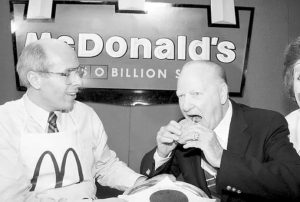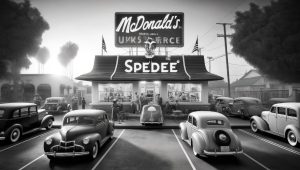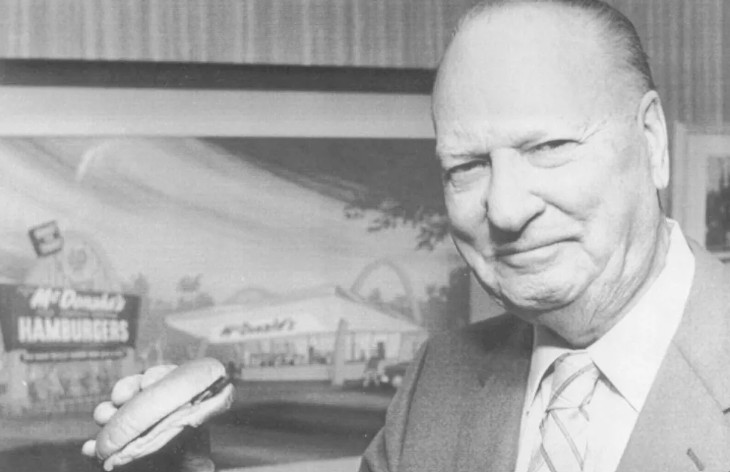McDonald’s, with its iconic golden arches, has become one of the most recognized symbols worldwide. Yet, behind this global empire lies the story of two brothers, Richard James McDonald and Maurice McDonald, who redefined the fast-food industry. They pioneered efficiency, consistency, and speed in food preparation, laying the foundation for modern fast-food chains.
But how did their financial story unfold? What was the net worth of Richard and Maurice McDonald, and how did their vision shape McDonald’s as we know it today? This blog dives deep into their lives, contributions, and the financial outcomes of their groundbreaking work.
Who Were Richard and Maurice McDonald?

Image – Source
Richard James McDonald and Maurice McDonald, often referred to as the McDonald brothers, were born in Manchester, New Hampshire, USA. Maurice, also known as “Mac,” was the elder of the two, born in 1902. While Richard was known for his innovative business strategies, Maurice managed the operational side of their ventures, ensuring the restaurant’s day-to-day activities ran smoothly.
The brothers shared a vision of creating an efficient and affordable dining experience for customers, which led them to open a drive-in restaurant in California during the 1930s. Together, they pioneered a system that transformed the fast-food industry forever.
How Was McDonald’s Created?
The McDonald brothers opened the first McDonald’s restaurant in San Bernardino, California, in 1940. This establishment was unlike any other it featured a limited menu of nine items, including hamburgers, fries, and milkshakes. The key to their success lay in their revolutionary Speedee Service System, which focused on:
- Efficiency: The kitchen was designed like an assembly line, allowing food to be prepared quickly and with minimal errors.
- Consistency: Each menu item was made to exact specifications, ensuring the same quality every time.
- Affordability: Streamlined operations allowed them to offer meals at lower prices, attracting families and individuals alike.
Maurice, or “Mac,” played a vital role in perfecting these operations, ensuring everything ran smoothly. His attention to detail and commitment to quality complemented Richard’s innovative ideas.
The restaurant’s success quickly drew attention, including that of Ray Kroc, who saw the potential for national franchising.
What Was the Net Worth of Richard and Maurice McDonald?
The McDonald brothers’ financial story is both inspiring and bittersweet. In 1961, Richard and Maurice sold their business to Ray Kroc for $2.7 million. At the time, this seemed like a generous amount, as it allowed them to retire comfortably. Adjusted for inflation, this sum is equivalent to approximately $26 million today.
However, the deal did not include royalties from the growing number of McDonald’s franchises, a crucial oversight that significantly limited their long-term earnings.
For Maurice, health concerns played a role in the decision to sell. Despite their innovations, neither brother benefited from the exponential financial growth that McDonald’s experienced under Ray Kroc’s leadership.
What Happened During the Ray Kroc Buyout?

Ray Kroc joined forces with the McDonald brothers in 1954 after discovering their restaurant during a sales visit. Impressed by their Speedee Service System, Kroc convinced the brothers to allow him to franchise their concept nationally.
However, tensions arose as Kroc’s ambitions for aggressive expansion clashed with the brothers’ conservative approach. By 1961, Kroc offered to buy the entire company, including the name and operating model.
The deal left the brothers with their original San Bernardino location, which they renamed “The Big M.” However, Kroc later opened a McDonald’s nearby, effectively driving them out of business. Maurice, in particular, was said to have been deeply disheartened by Kroc’s actions, feeling that their vision had been overshadowed.
What Is the Legacy of Richard and Maurice McDonald?
The McDonald brothers’ legacy goes far beyond financial figures. Their innovative approach to food preparation revolutionized the industry, creating a template that modern fast-food chains continue to follow.
Maurice’s operational genius ensured the system worked flawlessly, while Richard’s marketing insights laid the groundwork for McDonald’s branding. Together, they introduced the golden arches logo, which remains a symbol of quality, efficiency, and affordability.
Despite their early exit from the business, the brothers’ influence is celebrated at the McDonald’s museum, located at the site of their original restaurant in San Bernardino.
How Much Is McDonald’s Worth Today?
McDonald’s has grown far beyond the humble beginnings envisioned by Richard and Maurice McDonald. As of today, McDonald’s Corporation is valued at over $200 billion, making it one of the most valuable fast-food companies in the world. This global giant is not only a leader in the quick-service restaurant industry but also a powerhouse in real estate and franchising.
The company operates more than 38,000 outlets across over 100 countries, serving approximately 69 million customers daily. Its revenue exceeds $20 billion annually, primarily generated through franchising fees, royalties, and company-operated restaurants.
Breaking Down McDonald’s Worth
McDonald’s financial success stems from several key factors:
1. Global Expansion
The company’s strategy of aggressively expanding into international markets has been one of its defining strengths. Today, McDonald’s operates in every continent except Antarctica, adapting its menu to local tastes while maintaining its core offerings. This adaptability has helped the brand stay relevant and popular across diverse cultures.
2. Real Estate Empire
One lesser-known fact about McDonald’s is its massive real estate portfolio. The company owns a significant portion of the land and buildings its franchises operate on, making it one of the largest commercial real estate owners globally. This strategy allows McDonald’s to earn a steady income through rent from its franchisees, contributing billions to its bottom line.
3. Iconic Brand Recognition
McDonald’s is a household name, with its golden arches logo recognized by more people globally than some major religious symbols. The brand’s marketing efforts, from memorable advertisements to sponsorship deals with global events, have cemented its status as a cultural icon.
4. Diversified Menu and Innovation
While McDonald’s started with a simple menu, it has consistently evolved to meet consumer demands. The introduction of breakfast items, healthier alternatives, and limited-time offers has expanded its customer base. Iconic products like the Big Mac, Happy Meal, and McFlurry have become symbols of fast food, driving both sales and customer loyalty.
5. Franchising Model
McDonald’s franchising model allows it to grow its footprint rapidly without bearing the full cost of operating every outlet. Approximately 93% of McDonald’s locations are franchised, meaning the company earns a steady income through franchising fees and royalties while franchisees handle day-to-day operations.
How McDonald’s Compares to Competitors?

McDonald’s dwarfs most of its competitors in terms of market value and global presence. Here’s a snapshot of how it compares:
| Company | Market Value (Approx.) | Global Locations | Annual Revenue (Approx.) |
| McDonald’s | $200 billion | 38,000+ | $20 billion+ |
| Starbucks | $110 billion | 35,000+ | $32 billion |
| Burger King (RBI) | $22 billion | 19,000+ | $1.8 billion |
| KFC (Yum! Brands) | $40 billion | 25,000+ | $2 billion+ |
McDonald’s sheer scale, coupled with its diversified revenue streams, keeps it ahead of most competitors.
McDonald’s Success in Numbers
To appreciate the scale of McDonald’s financial success:
- 69 million customers served daily: That’s roughly 1% of the world’s population eating at McDonald’s every day.
- 1.5 million employees worldwide: Making it one of the largest employers globally.
- $10 billion in marketing spending annually: A budget that ensures the brand remains front and center in consumers’ minds.
- $3.2 billion net income (2023): Showcasing the profitability of its business model.
Reflection on the McDonald Brothers’ Vision

When Richard and Maurice McDonald envisioned their Speedee Service System, their goal was simple: provide quality food quickly and affordably. While the scale and scope of McDonald’s today may far exceed their original ambitions, the core principles of speed, efficiency, and consistency remain central to its operations.
Although the McDonald brothers did not financially benefit from this exponential growth, their vision laid the groundwork for one of the most successful businesses in history. Today, McDonald’s isn’t just a fast-food chain; it’s a global economic and cultural powerhouse.
Conclusion
Richard and Maurice McDonald’s net worth may not reflect the monumental success of the McDonald’s brand today, but their impact on the fast-food industry is undeniable. Together, they revolutionized dining, paving the way for a global empire.
Although overshadowed by Ray Kroc’s aggressive expansion tactics, the brothers’ vision and ingenuity remain at the heart of McDonald’s story. Their legacy is a reminder of how innovation and hard work can leave a lasting imprint on the world.
FAQ
What was Richard James McDonald’s net worth?
Richard McDonald’s net worth, after selling McDonald’s to Ray Kroc in 1961, was approximately $1.35 million (equivalent to $13 million today).
Why did the McDonald brothers sell their business?
The McDonald brothers sold their business to Ray Kroc in 1961 due to health concerns and a desire to retire, but the sale excluded future royalties from franchises.
How much is McDonald’s worth today?
McDonald’s is worth over $200 billion, with annual revenues exceeding $20 billion and more than 38,000 outlets worldwide.
What is the legacy of the McDonald brothers?
The McDonald brothers’ legacy lies in their pioneering of the Speedee Service System, which set the standard for modern fast-food operations.
How did Ray Kroc change McDonald’s?
Ray Kroc expanded McDonald’s into a global franchise, using aggressive marketing and franchising strategies to turn it into one of the largest fast-food empires.
What was the first McDonald’s restaurant like?
The first McDonald’s, opened in 1940 in San Bernardino, California, had a limited menu of nine items and introduced a system focused on speed, consistency, and affordability.
Featured Image – Source




